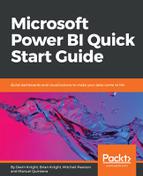Power BI makes some assumptions about your columns based on data types, column names, and relationships in the data model. These assumptions are used in the report view when building visualizations to improve your default experience with the tool. Once you start building visualizations, you will notice that Power BI selects different types of visuals for different columns; this is by design. Power BI also decides column placement within the fields section of a visual, and you will learn more about the creation of visuals in Chapter 5, Visualizing Data. As you saw previously in this chapter, when Power BI detects a column that has numeric values, a default aggregation is assigned. Power BI assumes you will want to aggregate that data, and will automatically place these numeric columns into the Values area of a report visual.
The classification of data allows you to improve the user experience as well as improve accuracy. There are quite a few different options available for data categorization, thirteen in fact. Take a look at the options available in the following screenshot:

The most common use for data categorization is the classification of geographical data. When geographical data is added to a map, Bing maps may have to make some assumptions about how to map that data. This can sometimes cause inaccurate results. However, through data classification, you can reduce and possibly eliminate inaccurate results.
https://tinyurl.com/pbiqs-categoryplace.

Follow the steps here to modify the data category:
- Select the report view from the left navigation bar.
- Expand the Sales Territory table and select Sales Territory Country, highlighted by a yellow box.
- Select the modeling ribbon.
- Click the dropdown for Data Category, and select Country/Region.
